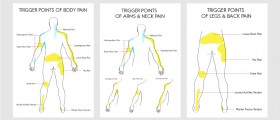
Piriformis is the muscle which connects the bone at the base of the spinal column (known as sacrum) with the thigh bone (the femur). It is located in the buttocks and its function is to help movement of the legs. Piriformis syndrome is neuromuscular disorder, causing pain in the buttocks and in the legs. However, this is not a disease but more set of symptoms of some other condition, such as sciatica, sciatic neuritis or herniated disc.
Symptoms of Piriformis Syndrome
It can also be presented as numbness and tingling in the legs, as well as some muscle weakness or difficulties with leg movements. Most patients have reported symptoms on one side of their body, but this type of pain may be felt on both sides. The pain is usually felt in lower buttocks and in some patients it can radiate to the thighs and lower legs, too.
Diagnosing Piriformis Syndrome
It is very hard to diagnose piriformis syndrome, so the diagnosis is usually based on exclusion of all other possible explanations involving spinal causes. To exclude other cause of pain, doctors could use X rays, MRI (magnetic resonance imaging) or CT scans, as well as some anesthetic injections or ultrasound. However, these methods can’t point to piriformis irritation and this is why doctors use magnetic resonance neurography.
What Causes Piriformis Syndrome?
Piriformis syndrome is said to be caused by compression or irritation of sciatic nerves. This condition may also be known as pseudosciatica or non-discogenic sciatica.
Shortening or tightening of piriformis muscle may also be responsible for this condition. This may happen after too much exercise, especially after too much walking or running. People who engaged in some physical activity for a long period of time, used ill-fitting shoes during exercise or worked out on some hard surface may also experience piriformis syndrome. Exercises on hard surfaces could also lead to the same problem and pain in the buttock region. Besides athletes, people who tend to sit for a long period of time may also develop this condition. Improper posture of the body and faulty body mechanics are also possible explanations about the cause of piriformis syndrome in some patients.
Treatment Measures for Piriformis Syndrome
Non-steroidal anti-inflammatory medications alone or combined with muscle relaxants are usually the first line of treatment for this condition. There are also some special exercises, recommended for people suffering from piriformis syndrome.
Doctors recommend avoiding strenuous physical activities. Physical therapy, alternate use of heat and ice packs and massage may also be very useful for piriformis syndrome patients. In some cases, doctors advise therapeutic injections or even surgical procedure, if everything else fails.

















Your thoughts on this
Loading...